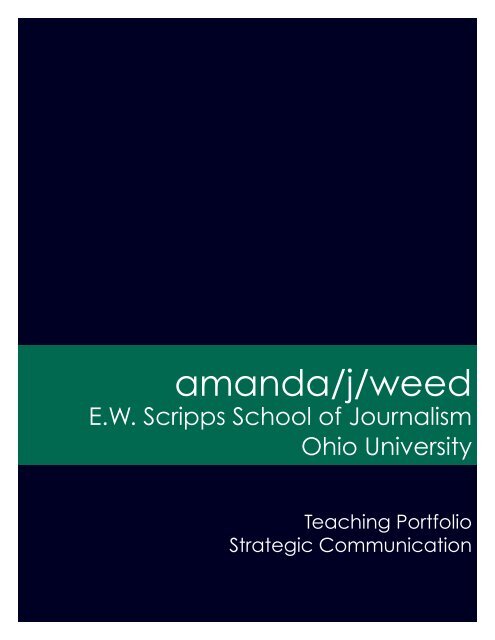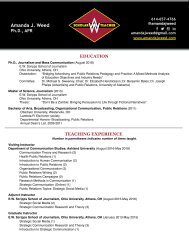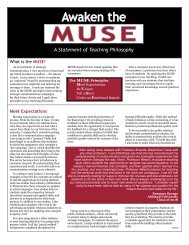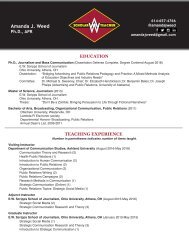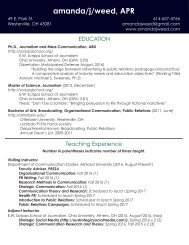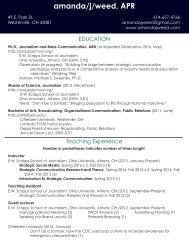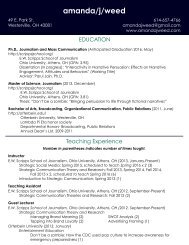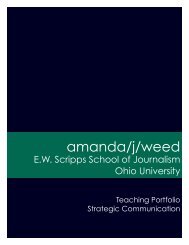Teaching Portfolio-Promising Professor
- No tags were found...
Create successful ePaper yourself
Turn your PDF publications into a flip-book with our unique Google optimized e-Paper software.
amanda/j/weedE.W. Scripps School of JournalismOhio University<strong>Teaching</strong> <strong>Portfolio</strong>Strategic Communication
amanda/j/weed 2Table of ContentsLetter of Application......................................................................3-6Student Endorsements.....................................................................7<strong>Teaching</strong> Evaluations..................................................................8-10Quantitative ..........................................................................................8Qualitative ........................................................................................9-10<strong>Teaching</strong> Philosophy.................................................................11-12Curriculum Vitae..........................................................................13-17Syllabi.................................................................................................18-33Strategic Social Media (Reflective Syllabus)...............................18-25Strategic Communication Theory & Research...........................26-33Examples of Assignments.......................................................34-42Quickfire Challenge..............................................................................34Example of Student Work................................................................35Social Media Campaign Proposal..................................................36-40Class Blog............................................................................................41News Story about Class Blog........................................................... 42For more information about Amanda,visit her website at www.amandajweed.com
amanda/j/weed 3Some professors are naturals. From the beginning, they know how to engage their students with brilliantinsights that stick with them for life. I am NOT that professor. I struggled at the beginning of myteaching career, but each semester I have made great strides in becoming a more effective instructor. Ibelieve many great professors are not naturals, but those “non-naturals” share four important qualities.First, they don’t fear failure in order to try new methods of learning. Second, they have the humility to learnfrom mistakes and the persistence to try again in new ways. Third, they learn from the guidance of those whomcan act as teaching mentors. Finally, they understand that the best teaching method is always a work-in-progress.My first experience as a teacher of record was a trial-by-fire, of sorts. I was originally scheduled to teach an introductoryjournalism lab, which was the standard beginning teaching assignment for graduate student instructorsin my program. Six days before the semester began, I received an email from my graduate director asking ifI was interested in teaching Introduction to Strategic Communication. Of course, I’ll teach the class! StrategicCommunication was my primary area of research and I hoped to teach in the discipline after I graduated. WhenI looked at the class registration, though, the color quickly drained from my face — 231 students! I soon realizedthat this class was one of the largest in the school. While I was nervous, I put on a brave face and thought, “Okay.You have the syllabus and teaching slides from the usual professor and you’ve observed his class several times.You can do this.” What I learned over the course of the semester is that students are keenly adept to learningwhen you are putting on an “act.” I was trying to mimic the usual instructor and I figuratively fell flat on my face.The teaching style that worked brilliantly for him came off as terribly stiff and awkward for me, and that reflectedin my teaching evaluations. What I learned from that experience is the importance of finding my own style as aninstructor instead of trying to “act” like what I thought a professor should be.After brushing myself off from my first teaching experience, I set out to discover what was my teaching style.I had an “a-ha” moment toward the end of my second term of teaching. I was teaching students about strategiccommunication andrealized that I couldapproach teachingin the same way as astrategic communicationcampaign. Byresearching my consumers(students) andtailoring my message,I could gain students’attention (engagement),awareness (retentionof knowledge),and action (appliedlearning). Throughthis process, I haveapplied several teachingstrategies that haveimproved the learningexperience for mystudents.Improvement of Mean Quantitative Evaluation Score Over TimeImplementation ofCampaign Planning Strategy in<strong>Teaching</strong> Design*Evaluations conducted on 5-point scale
amanda/j/weed 4Gamification of LearningIn Strategic Social Media and Strategic Communication Theory & Research,I use gamification in several ways. First, after students make pitches to theclass, I will ask the students to vote for the team they would “hire” based ontheir pitch. The winning team receives a “Top Pitch” award and a small jokeprizes such as chocolate money or a PayDay candy bar. While these gameelements of the class have no effect on students’ grades, it has created a greatersense of pride from students for their work and adds an element of fun to theassignment. The Top Pitch Award becomes an accomplishment that studentscan list on their resumes to expand their marketability to future employers.Another form of class gamification I used was to illustrate the concept of blog views and visitors for the studentsof Strategic Social Media. During our Twitter blog promotions, students often promote individual pages.While the promotions led to a high number of visitors, those visitors did not explore beyond the promoted page.To show students a method of increasing pages views per blog visitor, I created a Golden Egg Hunt for the blog.In that contest, vistors who clicked the goldenegg were able to enter into a contest for a$10 Chipotle card. The golden egg contestworked very well and increased our pagesviews from an average of 1.5 views per visitorto 4.65 views during the promotion.A final example of gamification encourages students to build their personal “brand.” During my introductorysurvey of students in Strategic Social Media, the majority of students wanted to learn how to use social media toto network for a future job. To developtheir professional persona online,I wanted them to become comfortablewith promoting their work. Toup-the-ante for our final blog promotionfor the semester, I offered the“George Takei Award for Social MediaSelf-Promotion,” which was awardedto the student who received the mostpage views on any one assignmentthey have published on our class blog.The Puzzle-Method of Project DesignIn Strategic Social Media and Strategic Communication Theory & Research, I have incorporated beneficialstrategies in project design. I have found that my students are very successful when large projects are brokendown into smaller assignments over the course of the semester. Those smaller assignments become pieces of apuzzle that are later put together into a final project. The assignments often serve as a testing ground for morecreativity because students have a safety net, so to speak. If they don’t do as well as they like the first time, theyhave a second chance to make improvements when the smaller assignment is incorporated in the larger finalproject (which is worth more points). The “puzzle-method” often results in a more professional project thatbecomes an impressive addition to a student’s job portfolio.Peer FeedbackStudents Wyatt K., Katlyn D. andKaylee P. with their Top Pitch AwardAnother uncommon assignment I include in class design is peer feedback sessions. Student teams are pairedtogether and they present a rough pitch of their campaign idea to each other. What is unusual about that assignmentis that students are not graded on the presentation, but the quality of feedback they provide to their partner
amanda/j/weed 5team. This type of assignment serves two purposes. First, the feedback session acts as a dress rehearsal for thefinal pitch presentation. Second, by grading the quality of feedback, students are developing their critical thinkingskills in relation to the core concepts they have learned and then applying those skills toward constructivefeedback.Collaboration with Industry ProfessionalsI believe in the importance of providing opportunitiesfor students to learn from industryprofessionals. While I can provide a foundationof knowledge in strategic communication, invitingindustry professionals to speak with students putsthe knowledge they have learned into a practicalcontext. In Strategic Social Media, we had fourguest speakers during the semester, each comingfrom different industries. One unique aspect ofthose guest-speaking engagements was the incorporationof live tweet coverage produced by thestudents. Live tweeting serves several purposes.First, live tweets creates direct engagement withthe speaker because students are sharing their keyStudent Rachael P. demonstrates the #ouj4530 Twitter board.insights from the presentation. Second, live tweets creates a connection with larger audiences when students useengagement elements such as tags and hashtags that are directly to the guest speaker and their employer. Finally,live tweets are archived on the class blog, which are later promoted by the class in their Twitter blog promotioncampaign.In addition to in-class lectures, I have worked with industry professionalsand researchers for college-wide speaking engagements.“Building Brand You,” now in its third year, teaches students how tocreate a personal brand that will set them apart when applying forinternships and jobs. I initially recruited Pete Costanza, Jr., foundingpartner of Marsh Brand Partners, as a guest speaker in 2012, and hehas returned each year as the talk has grown in popularity. I have alsocreated an intra-university partnership with “The (not so) Secret Liveof Avatars,” which featured Dr. Nicholas Bowman, a game researcherfrom West Virginia University’s Department of CommunicationStudies.Progressive EvaluationsEach class I teach becomes an opportunity to gain self-discovery of how I could improve my teaching skills.One core element I teach (though some might say “drill”) my students in strategic communication is the necessityto conduct evaluations before, during, and after a campaign. By applying this method of campaign evaluation,I have been able to gain insights that have greatly improved my course design, even in the middle of a semester. Ialso discovered that when students feel that their input has an influence on the class design, they exhibit a greatersense of ownership and commitment to the outcomes of the class.To incorporate campaign evaluation methods into my teaching plan I follow the same before, during and afterstrategy I teach my students. To gain an understanding of my students, I administer a survey during the first dayof each of my classes that asks questions about their incoming knowledge/skills, work experience, time commitments,and their learning objectives for the class. I use this information to refine my class projects and to identifyopportunities for tailored learning for each group of students I teach.
amanda/j/weed 6By conducting “mid-campaign” evaluations, I able testwhether my lectures and assignments are meeting thelearning objectives for my class. One example of how thistype of evaluation benefited my class design was with theQuickfire Challenge. The Quickfire Challenge began whenI wanted students to think about how user-generated content(content that is produced and posted by social mediaconsumers) could be incorporated in strategic communicationcampaigns. In the Quickfire Challenge, I formedsmall students teams and gave those teams the same client,campaign goal, and the concept they needed to includein the campaign (user-generated content). Student teamshad one class to form their campaign idea, which was thenpitched during the next class meeting.I was so impressed with the Quickfire pitches from studentsthat I felt it would be useful to incorporate more of those assignmentsin the class, but I didn’t want students to feel overwhelmedby the additional workload. So, I took an anonymous vote fromthe students asking if they would like to do the Quickfire Challengesagain. After a unanimous “yes” vote, I made an adjustmentto the syllabus to replace a class quiz with two more QuickfireChallenges. The Quickfire Challenges still demonstrated theretention of knowledge from class lectures but put that knowledgeinto “hands-on” application. Through using democraticapproach to evolve the class design, I believe my students felt agreater sense of commitment to produce higher-quality workthat illustrated their knowledge of concepts they learned in class.Students Betsy N., Carly G. and Olivia U. make theirUGC Quickfire pitch for the Athens Farmers MarketStudents Gina R., Caroline W. and Olivia U. make theirTapping Trends Quickfire pitch for ModClothFinally, I conduct a “post-campaign” evaluation by carefully analyzing the feedback I receive from my teachingevaluations. Each semester, I make a personal goal to revise my class design to address an area for improvementthat my students identified. One example of how I used student feedback to make improvement is with my assignmentguides. In my early teaching evaluations, students assessed the clarity of assignment instructions lowerthan I would like. In subsequent classes, I created more detailed assignment guides for large projects. Whilethose new assignment guides are often intimidating at first, I believe the assignment guides provide transparencyto how students’ work is assessed for grades. As a result, I have had very few grade challenges since implementingthe new style of assignment guides, and my evaluation scores in that area have increased significantly.In conclusion, I have started the path of a life-long learning journey that will never have an end point. I amstill in the early stage of self-discovery as a professor and I look forward to gaining more insights in the futureto continue my improvement and refine my skills. I was not born a great professor, but it is my lifetime goal tobecome the best professor I can be to propel my students to their own success.Amanda J. WeedPh.D. Student/InstructorE.W. Scripps School of JournalismOhio University
Endorsements from Former Studentsamanda/j/weed 7“<strong>Professor</strong> Amanda Weed has an obvious passion for strategic communications, but it wasn’t until I took a class with her that I realized her passion forteaching is just as strong. She takes an ordinary curriculum and makes it a realistic job experience, completely changing the game in conventional teaching.In her Strategic Social Media class, <strong>Professor</strong> Weed revolutionized the traditional journalism classroom, and challenged each of her students to thinklike a young professional in the online communications industry. Not only has Amanda taught me and many other students at Ohio University, but shealso takes special care in being a mentor to all who reach out to her. She single-handedly directed me towards my career path, and I cannot wait to seethe amazing things she will accomplish in the future.”Betsy N.Strategic Social Media (Spring ‘15)Strategic Communication Theory and Research (Spring ‘14)“My first class with <strong>Professor</strong> Weed was in a room for over 200 students. Not only did <strong>Professor</strong> Weed keep everyone involved in the discussion, she alsomade it fun, insightful and very informative. Her lectures are based on practicality and helped us develop and hone the skills we need for successfulcareers. In the Strategic Communications Theory and Research class, her counsel was invaluable. She worked closely with each group, providing us withresources and advice. The creative brief my team worked on was very well received by the brand we were assigned to. I doubt it could’ve been possiblewithout <strong>Professor</strong> Weed’s guidance. She is a great mentor and I often seek her advice on projects I’m working on. She always makes time for her studentsand is always willing to help out. I have used many of the skills that I learned in her class in my internships and I always recommend her class to studentswho are thinking about a career in PR or Advertising.”Udit S.Introduction to Strategic Communication (Spring ’13)Strategic Communication Theory and Research (Fall ’13)“After taking two strategic communication courses from <strong>Professor</strong> Weed, I can say with confidence that she is not only a wonderful professor, but agreat mentor as well. The two courses I took from her were formatted completely differently (one being a large lecture, and one being a small discussionclass), yet she managed to create an environment that was conducive to learning, and welcoming to discussion. Outside of the classroom, <strong>Professor</strong> Weedembodies what it means to be a mentor. She always made time for her students to meet with her to discuss anything from class work to current trends incommunications, and fostered genuine relationships outside the walls of the classroom. I truly believe her classes have prepared me to be a better communicationsprofessional, and I look forward to taking more of her courses in the future.”Sydney G.Introduction to Strategic Communication (Spring ’13)Strategic Communication Theory and Research (Spring ’14)” After having taken Strategic Communication Theory and Research with Amanda Weed already, I decided to take her next class: Strategic Social Media.I didn’t realize how big of an impact that decision would have on me. I have learned more in the 15-week class than I did in any other class I hadtaken in my then 3 years of school. We had hands on experience and heard from professionals who had to deal with Social Media in their careers. Thenetworking alone from that class made it worthwhile. Projects from the class had us doing things with real companies, making it a real-life experience.Using information and tools created by professionals and wasn’t made up from a text book gave us a better understanding of what it would be like in thereal world.Due to the experiences from the class and also the work that I did, I was able to land a Social Media internship and beat out students from other eliteuniversities. The knowledge I gained will be useful throughout my entire future career in Social Media. I am so thankful to this class for the opportunitiesit presented to me and Amanda will be a hero of mine forever. I hope we stay connected in the future and that other students come to see what avaluable teacher and person she is.”Elicia G.Strategic Social Media (Spring ‘15)Strategic Communication Theory and Research (Fall ‘14)“<strong>Professor</strong> Weed is an incredibly knowledgeable, helpful, and encouraging instructor, which she demonstrated particularly well in her teaching of StrategicCommunication Theory and Research. In this course, students were given the task of conducting secondary and primary research and then usingour findings to develop a detailed and effective creative brief for a real client—all skills we will need to develop and use in a strategic communicationsposition after graduation. She holds our work to high standards but responds quickly with feedback on how we can improve as well as answering anyquestions we may have. The work that I completed in <strong>Professor</strong> Weed’s class has prepared me for what lies ahead in my future in strategic communicationand I am grateful to have had a professor who is so approachable, knowledgeable, and who encourages us to put in our absolute best effort to createthe best end result.”Holly C.Strategic Communication Theory and Research (Spring ’14)Additional student endorsements are available athttp://amandajweed.com/student-endorsements/
Quantitative <strong>Teaching</strong> EvaluationFall 2013-Spring 2015amanda/j/weed 8
Qualitative <strong>Teaching</strong> EvaluationFall 2013-Spring 2015Positive Feedbackamanda/j/weed 9“Unlike a lot of classes, this classes gave me the opportunity to complete assignments I could keep in a portfolio to forward on to potential employers.I found this to to extremely beneficial. A lot of classes assignments are only relevant to that particular class and cannot be applied to the outsideworld. In this class, we did research on real companies and created campaigns that companies could very easily use in their business. We also used aclass blog which I can forever have the link to and forward on to employers as well so they can see my work.”“I loved this class and I think Mrs. Weed will make a fantastic professor!”“One of my favorite journalism classes. We did “quick fire” challenges that made us think and act on real life pitches that could happen within companies.”“I am really happy with the way <strong>Professor</strong> Weed breaks down the final assignment into several smaller assignments. It gives us the opportunity toreceive feedback and make edits before completing the final, it also makes the final assignment more manageable and understandable.”“She always gave clear and very detailed direction for assignments. The assignments were very beneficial and relevant. They were set up in a wayso that they didn’t just feel like a typical project or assignment, but so that they felt like they were a real-life job. The evaluation of our assignmentsand work was always based on a rubric that she would give us before the assignment was started, and attached to our final project as well. She wasalways clear about where we didn’t receive points and why.”“Mrs. Weed was very knowledgeable. She really explained everything clearly and put it in an organized and understandable manner. ““I learned a lot of new things in this class and was challenged to think outside the box for campaign pitches. We were also encouraged in discussionsto participate and tweet out anything we thought was interesting.”“She was very knowledgeable. She always presented the material in different ways that would appeal to different learning styles. Sometimes wefollowed a powerpoint, sometimes we had open discussion, other times we watched videos and were assigned articles that were relevant to the classcontent. The course was organized as well. Any time there were changes or hiccups in the schedule, she adjusted accordingly. She was also veryaccessible and easy to communicate with on a last-minute basis.”“She encouraged a lot of discussion and brought real world situations into the class which I liked and challenged me.”“<strong>Teaching</strong> ways were challenging but always pushed me to produce something better or think in different ways. She was very encouraging throughoutclass.”“I really enjoyed how Amanda added a critical thought process to the class through case studies and current ads/trends - and apply the subjectmatter in different ways. We applied concepts in a realistic way. Discussion and participation was encouraged daily.”“<strong>Professor</strong> Weed definitely challenged me throughout this course. She gave a lot of different examples for almost every topic, which helped me thinkabout the subject matter in new ways. And she did encourage discussion and participation. Our class participated a lot and it wasn’t like pullingteeth like in most classes.”“Yes, everything was clearly explained as for what she wanted out of us. The projects were very helpful in giving us a first look at exactly what we aredoing in this subject and how you must go about getting research and putting it together.”“The course was well organized. I appreciate the small projects throughout the semester, because they helped us work toward our final creativebrief. Amanda was extremely knowledgeable, and made learning the material exciting.”“She was very good at explaining how everything fit together in the subject matter and made it really interesting. I liked how we got hands onexperience and still a lecture as to what we’re doing.”“<strong>Professor</strong> Weed is a phenomenal instructor who really knows her stuff. She’s relatable, down-to-earth, funny, and always willing to help. I reallyfeel like I learned a lot of valuable information from her class.”
amanda/j/weed 10Qualitative <strong>Teaching</strong> EvaluationFall 2013-Spring 2014Areas of ImprovementSpring 2014“The only problem I ran into was some unclear sections of the final project, but Amanda was willing to call my group at 6p.m. on a Friday to help us clear things up, which we greatly appreciated.”“Course materials were somewhat explained. I think it would have been helpful to go over the assignments in class so it isclear what is wanted and needed out of each project. That being said, the assignments did greatly help me understand thematerial and gave me great experience!”The above comments led me to revise my assignments guides to be more explicit, and to clearly break down the requiredelements and point values. In addition, I set aside a portion of the class to go over large assignments and to answer questions.Subsequent feedback on the clarity of assignments and grading criteria have shown much improvement.Fall 2013“The class had both exams and projects, which were often scheduled for the same week. It was very overwhelming tryingto teach YOURSELF the book material for the test, and then turn in a HUGE group project. Not only did the test consistof PAGES of notes from class, it was based off 10 chapters of the book (30 for the final), which was NOT reviewed in class.The projects really did not reflect what we learned in class. I could understand how they are both part of Strat Comm, butthe course load was outrageous. Also, EVERY ASSIGNMENT WAS GROUP BASED. It was SO difficult to find time toconsistently meet up with 3 other people. Not only was this for our huge projects, but even for small projects. (Small meaning,they were 3 pages long and only worth 5 points.) It was a lot expected from us. We are not grad students. We are in 5classes. We have jobs. We are involved in clubs, greek life, volunteer.”While this comment was hard to read at first, it was also one of the most beneficial forms of criticism I have received asa professor. I did not realize students were taking five classes or more per semester, working part-time jobs and were involvedin several student organizations. Now I conduct a student survey at the beginning of each semester to understandstudents’ commitements outside of class. I have also increased the number team work days (in-and-outside of class),balanced individual assignments with team projects, and implemented the “puzzle-method” for large projects.
amanda/j/weed 11As an instructor of strategic communication,I view myself as a brand and my brandproduces a product — the classes I teach. Inmy classes, I strive to maintain an “authentic”brand by understanding my consumers (mystudents) and tailoring my message to them.I teach my students the value of the MUSEprinciples when creating strategic communicationscampaigns for their future clients andI apply these principles to my teaching philosophy.MUSE stands for four brand qualitiesthat are essential when communicating withconsumers.What is the MUSE?The MUSE PrinciplesMeet expectationsUniqueStoryEmotionsLike a company has its key client base ofconsumers, a professor has their client base ofstudents. By applying the MUSE principlesto my teaching, I build connections with mystudents that facilitate learning and encouragesthem to apply their newfound knowledgetoward practical experience.amanda/j/weedPh.D. Student/InstructorE.W. Scripps School of JournalismOhio Universityamandajweed@gmail.comwww.amandajweed.comAwaken theMUSEA Statement of <strong>Teaching</strong> PhilosophyMeet ExpectationsMeeting expectations is a reciprocal process.From the first day of class, I create an environmentwhere my students know what they canexpect from me and what I expect from them.Offering a detailed syllabus is one way I createtransparency in my class. When I write asyllabus, I include information about the classschedule and assignments, but also what mystudents may expect of me and what I expectof them.In Strategic Communication Theory andResearch, group work is a critical part of thelearning experience. The advertising and publicrelations industries rely heavily on projectteams to design and execute strategic campaigns.To replicate the agency environment,I assign students teams based on their workstrengths. While this method of team formationis time-consuming, it is has resulted in atrack record of highly-successful teams thathave produced professional quality creativebriefs.In my class assignments, I allow students tomeet learning objectives in a progressive manner.The final project of the class is a creativebrief, which includes primary and secondaryconsumer research, an analysis of their “client,”and a proposed strategic communicationcampaign. The creative brief can be a dauntingtask for a novice, so I break up the project overthe course of the semester. I emphasize the importanceof consumer research in this class, sostudents submit first drafts of their secondaryand primary research. For those drafts, I giveextensive feedback so students may improvetheir work before submitting their final brief.To reinforce the class lectures, I incorporate examplesof how the key concepts are utilized inreal-life applications. One method I use is tohave students read case studies from the WorldAdvertising Research Center (WARC) toillustrate how those key concepts are applied inactual campaigns. The use of case studies helpsmy students make the connection betweentheoretical concepts and applied skills, and alsoserves as inspiration for their team projects. Inaddition to case studies, I also schedule guestspeakers who work in the advertising and publicrelations industries to discuss how they areapplying class concepts in agency work.“<strong>Professor</strong> Weed is one of the best teachers I have had throughoutmy academic career...The way she teaches makes studentswant to learn more; she challenges students and pushes them toproduce high quality work. Each reading, lecture, homework, andproject students are assigned enforced what we were learning inthe class and gave students a chance to apply what we learnedto real life situations.”Sara M.Strategic Communication Theory and Research (Spring ‘14)To be successful in the advertising and publicrelations industry, the ability to constructivelyevaluate the work of others is a necessary skill.To build that skill, I ask teams to make informalpresentations of their research-in-progress.Students are not evaluated on the presentation,but the quality of feedback they provideto the team they are evaluating. In additionto providing feedback to their peers, I also askfor feedback about my teaching by talking withstudents before-and-after class and through aninformal mid-term evaluation. ~over~
amanda/j/weed 12A Unique ExperienceI have learned that the dynamic ofeach class is unique even when I amteaching the same course. To learnabout this dynamic early on, the firstassignment I have my students completeis a personal survey. In the survey,I ask about their previous experience instrategic communication; time commitmentsbetween classes, work, andstudent organizations; what methodsthey use to understand class material;and what skills they hope to gain fromthe class. I use this knowledge to makeadjustments in my course design tohelp students have the best opportunitiesto succeed in the class.Allowing students to be co-collaboratorsin the learning process is anotherway I create a unique learning environment.In the first phase of their creativebrief projects, I allow student teamsthe freedom to choose the consumergroup they wish to research. Duringtheir selection process, I provide guidanceabout what consumers groupsmay have more existing data to helpin their research. Ultimately, though, Ileave the final decision to the team. Byallowing them freedom to choose theirconsumer, they more likely to feel anadded ownership of the project.I recognize that each student mayalso bring unique contributions to classdiscussions and their assignments. Ichallenge students to think “outside ofthe box” to find creative solutions tostrategic communications problems. Intheir creative brief projects, I purposefullyassign teams to “clients” that theydo not know. When students have thechoice to work on projects for organizationswith which they are familiar, itmay be difficult for them to break newground. By selecting unfamiliar clients,they are given a “clean slate” fromwhich to start their projects. Often, theprocess is uncomfortable at first but, inthe end, it keeps students focused onmeeting the key goals of the creativebrief.Weaving Stories into LearningI believe that a variety of learning methodshelps students retain and recall information.As part of my teaching method, Iutilize readings, lectures, class discussion,and multimedia examples to reinforcekey concepts of the class. I challenge mystudents to go beyond recall of informationto critically evaluate examples from theadvertising and public relations industries.Each semester, I select a core group of classiccampaigns, as well as current examples.I also encourage students to share examplesof campaigns that they feel are relevantto our key concepts. Encouraging theirinvolvement allows my students to thinkabout our learning objectives in a contextthey feel is personally relevant.Creating stories are also ways in whichstudents can exhibit their learning of classconcepts. When students are describingAdvertising and public relations campaignsoften tap into the emotions of consumers todraw interest to the strategic message. Theconsumer often doesn’t have automatic recalla strategic message based on the wordsbut, instead, the emotions are the trigger tomessage recall. When I choose examplesof campaigns to reinforce lecture topics, Ioften select examples that use emotionalundertones to reach the consumer. Whenwe discuss the examples, I begin by askingtheir emotional response, and then moveto the analysis of the message. I find thismethod helps students to recall informationwith greater ease.Another way to harness emotions is by providingconsistent feedback to my studentson their contributions on their work. Ibelieve that instruction is only one serviceI provide to students. I welcome studentsHarnessing Emotionstheir consumers and client in the creativebrief, I explain that I want them to tellme a “research story.” To help them bringtheir research story to life, I have developedassignments encourage them to thinkabout their consumers and clients as actualpeople.One assignment that helps students createa research story is the brand personal ad.Students create a personal ad written fromthe perspective of their client who is lookingfor a “date” with their desired consumer.I encourage students to be creative in writingthe personal and, most of all, to havefun with it. I have found the assignmentallows students to envision their clientsand consumers as actual people having aconversation, which helps immensely in thebrainstorming and development phase oftheir strategic communication campaign.to visit during my office hours if they wantto talk more about class topics or how toprepare for future internships and jobs.In addition to one-on-one advise, I havebeen the event planner for “Building BrandYou,” now in its third year. “Building BrandYou” teaches students how to begin buildinga personal brand to set themselves apartfrom the competition when applying for internshipsand jobs. Each year, the event hasgrown in popularity is now a college-wideevent.The final way I harness emotions is to tempermy constructive feedback with positivereinforcement. Many talents do not comenaturally, but must be nurtured. By sharingmy enthusiasm for the potential in theirwork, I believe my students will achievesuccess.amanda/j/weedPh.D. Student/InstructorStrategic Communication Theory and ResearchE.W. Scripps School of JournalismOhio UniversitySpring 2014E.W. Scripps School of JournalismOhio Universityamandajweed@gmail.comwww.amandajweed.com
49 E. Park St.Westerville, OH 43081amanda/j/weedEDUCATION614-657-4766amandajweed@gmail.comwww.amandajweed.comPh.D., Journalism and Mass Communication (Anticipated Graduation 2015, May)http://scrippsjschool.org/E.W. Scripps School of JournalismOhio University, Athens, OH (GPA: 3.95)Master of Science, Journalism (2013, December)http://scrippsjschool.org/E.W. Scripps School of JournalismOhio University, Athens, OH (GPA: 3.81)Thesis: “Don’t be a zombie: Bringing persuasion to life through fictional narratives”Bachelor of Arts, Broadcasting, Organizational Communication, Public Relations (2011, June)http://otterbein.edu/Otterbein University, Westerville, OHLambda Pi Eta honor societyDepartmental Honors- Broadcasting, Public RelationsAnnual Dean’s List, 2009-2011<strong>Teaching</strong> ExperienceNumber in parentheses indicates number of times taught.InstructorE.W. Scripps School of Journalism, Ohio University, Athens, OH (2013, January-Present)Strategic Social Media; Spring 2015, scheduled to teach Fall 2015 (2)Strategic Communication Theory and Research; Fall 2013, Spring 2014, Fall 2014,scheduled to teach Fall 2015 (4)Introduction to Strategic Communication; Spring 2013 (1)<strong>Teaching</strong> AssistantE.W. Scripps School of Journalism, Ohio University, Athens, OH (2012, September-Present)Strategic Communication Theories and Research; Fall 2012 (2)Guest LecturerE.W. Scripps School of Journalism, Ohio University, Athens, OH (2012, September-Present)Strategic Communication Theory and ResearchManaging Brand Meaning (2)SWOT Analysis (2)Tapping into Brand Loyalty (2)Strategic Communication PrinciplesAdvertising Framing and Counter-Framing (1)Otterbein University (2013, January)Entertainment EducationDon’t be a zombie: How the CDC used pop culture to increase awareness foremergency preparedness (1)
SCHOLARLY ACTIVITYamanda/j/weed 14PublicationsWeed, A.J. (2014). We’re Trekkers, too: How customer service failure became an internet meme.Journal of Critical Incidents, 7.Weed, A. J., & Davis, C. (2013). American Apparel and the “XLent” contest. Business CaseJournal, 20(1), 1.Conference PresentationsWeed, A.J. (2015, March). An un-happy meal?: The rise and fall of #mcdstories. Presented atthe MBAA Internation annual conference, Chicago, IL.Weed, A.J. (2015, March). Engaging consumers with advergames: A case study of Chipotle’sThe Scarecrow. Presented at the MBAA International annual convention, Chicago, IL.Weed, A.J. (2014, November). Picture This: Privacy Expectations and Practices Between Genderand Age Groups in Picture Sharing on Facebook. Presented at the NCA annualconference, Chicago, IL.Seifert, J. and Weed, A.J. (2014, October). Tell Me, But Don’t Tell Me: An Exploratory Study ofMandatory Health Campaigns on Campus. Presented at the Ohio CommunicationAssociation annual conference, Columbus, OH.Weed, A.J. and Beauchamp, A. (2014, August). Persuasive Storytelling in the Interactive Age: ATheoretical Model Explaining Interactivity Effects in Narrative Persuasion. Presented at theAEJMC annual convention, Montéal, Canada. Chaffee-McLeod Award for Top StudentPaper.Jain, P., Weed, A.J., and Walck, P.E. (2014, August). Connecting With Celebrities On Twitter AndFacebook: A Narrative Processing Approach. Presented at the AEJMC annualconvention, Montréal, Canada.Weed, A.J. (2014, March). As the World Churns: Food Network and Butter Wrapper Protest toSave Paula Deen. Paper presented at the MBAA International annual conference,Chicago, IL.Weed, A.J. (2014, February). Occupy the Agenda: Effects of Newspaper Coverage on thePublic’s Perception of Occupy Wall Street. Paper presented at The Ray BrowneConference on Popular Culture, Bowling Green, OH.Weed, A.J. (2013, August). The activist network: How Wikipedia used Facebook posts and sharesto gain support for the SOPA/PIPA blackout. Paper presented at the AEJMC annualconvention, Washington, D.C.Weed, A.J. (2013, July). Don’t let the zombies get you: How the CDC used novelty to reachnew audiences. Paper presented at the Society for Case Research Summer Writer’sWorkshop, Danbury, CT.Weed, A.J. (2013, March), “We’re Trekkers, too”: How customer service failure became aninternet meme. Paper presented at the MBAA International Annual Conference,Chicago, IL.Weed, A.J. and Davis, C. (2012, July). American Apparel and the “XLent” contest. Paperpresented at the Society for Case Research Summer Writer’s Workshop, Springfield, MO.Scholarship Award for Top Student Paper.Srivastava, J. and Weed, A.J. (2012, June). “Friending” to fight cancer: The nature of contentand social support of the American Cancer Society fan page on Facebook. Paperpresented at the International Conference on Global Health & Crisis Communication,Eskisehir, Turkey.
amanda/j/weed 15Honors and AwardsChaffee-McLeod Award for Top Student Paper, Communication Theory and MethodologyDivision, AEJMC (2014, August)Awarded for Persuasive Storytelling in the Interactive Age: A Theoretical Model ExplainingInteractivity Effects in Narrative Persuasion.Doctoral Honors Seminar, NCA (2014, July)Mass Communication GroupApproximately 10 doctoral students are chosen nationwide to participate based onsubmitted papers and recommendations from their advisors.Nominee, K. Patricia Cross Future Leaders Award, Association of American Colleges &Universities (2013, October)Recognizes graduate students who show exemplary promise as future leaders of highereducation.Top Student Paper Scholarship, Society for Case Research (2012, July)Awarded for American Apparel and the “XLent” Contest.Robert L. and Teri W. Gerbig Graduate Scholarship, Ohio University (2011, May)AAF Columbus (2014, September-Present)PRSA (2014, January-Present)Current Division MembershipsCentral Ohio PRSANCA (2014, August-Present)MembershipsEducators AcademyAEJMC (2012, August-Present)Current Division/Interest Group MembershipsAdvertising DivisionCommunication Theory & Methodology DivisionGraduate Student Interest Group Mass Communication & Society DivisionPublic Relations DivisionSociety for Case Research (2012, July-Present)SCHOLARLY ACTIVITY CON’TInvited PresentationsWeed, A.J. (2015, August). Building brand you: Creating a personal brand to land the job youlove. To be presented at the AEJMC annual convention, San Francisco, CA.Weed, A.J. (2014, August). The #socialclassroom: How social media can enhance the learningexperience. Presented at the AEJMC annual convention, Montréal, Canada.
Serviceamanda/j/weed 16Professional AssociationsAEJMCHead, Graduate Student Interest Group (2014, August-Present)Vice Head/Programming Chair, Graduate Student Interest Group (2013-2014)Membership Chair, Graduate Student Interest Group (2012-2013)Society for Case ResearchAt Large Director (2014, March-Present)Reviewer (2012-Present)Journal of Critical IncidentsReviewer (2013, March-Present)Association of Alternative NewsweekliesReviewer (2013, April-Present)University-Wide ServiceOhio UniversityMember, Interdisciplinary Council (2013, August-2014, August)Member, Library Council (2013, August-2014, August)Senator, Scripps College of Communication, Graduate Student Senate (2013, August-2014, August)Event Coordinator, Building Brand “You” (2014, February)Representative, E.W. Scripps School of Journalism, Graduate Student Senate (2012,August-2013, August)Otterbein UniversityMember, Academic Council (2010-2011)Member, Institution Effectiveness Committee (2010-2011)Departmental ServiceOhio UniversityMember, Search Committee, Strategic Communication Faculty (2011)Member, Search Committee, Strategic Communication Visiting <strong>Professor</strong> (2011)Event Coordinator, “Building Brand You” Seminar (2012, November; 2012, April)Community ServiceMember, Communications Committee, CHA Animal Shelter, Westerville, OH (2008-2011)Event Coordinator, Carnival for Hope, Westerville, OH (2010)Marketing Team Leader, Leadership Westerville, Westerville, OH (2002-2003)Academic Work ExperienceResearch Assistant, E.W. Scripps School of Journalism, Athens, OH (2012-2013)Graduate Assistant, Voinovich School of Leadership and Public Affairs, Athens, OH (September-November 2011)
amanda/j/weed 17Professional Work ExperienceBranding Consultant, Westerville, OH (2010-Present)Develop branding strategies for food industry businesses including menus, advertising,and social media marketing.Owner, Sweet Dreams Chocolatier, Westerville, OH (2002-2011)Managed all aspects of business including menu & marketing material design, newbusiness development, and account management.Office Administrator, Active Aeration Systems, Inc., Plain City, OH (1999-2008)Managed dealer/government relations, marketing material design, and accountmanagement.Producer, Clear Channel Communication, Columbus, OH (1997-1999)Syndicated radio show producer (WTVN, WCOL) and morning show producer (WHOK).Commercial Production Assistant, Clear Channel Communication, Columbus, OH (1997-1999)Produced and voiced local commercials.
amanda/j/weed 18Twitter has become a valuable channelfor quick communication and tobuild rapport with students outsideof class.I often host in-person office hours after class meeting times, butI often find students prefer to chat via social media or email.Next semester, I will promote my “virtual” availability (throughGoogle chat and Twitter) during these times to see if more studentsparticipate in office hours.I reviewed several possible texts, butno one text could satisfy my learninggoals for the class. I felt the combinationof academic and industryarticles provided the strongest foundationfor students.These industry resources providedseveral articles that were requiredreadings for the class. In thefuture, these are news sources andindustry professional that studentsshould follow to stay up-to-dateon the social media developmentsand how they can be best used bybusinesses and organizations.*As the semester progessed, studentsadded to this list of resourceson our class blog.
amanda/j/weed 19The purpose of the course descriptionwas to let students know thatthis class if more than retaining andrecalling information. I wanted studentsto sense that there is a story tobe told about social media, and howthe assignments of the class supportthe story.I believe it is important for studentsto know exactly what they will gainfrom the class I teach from the firstday. I consider this to be a “contract”with the student. If they makea commitment to the class, theseare skills and knowledge that will betheir return on investment.The class rules sets the appropriatebehavior in class, but also acts aguide for students to get the mostout of the class.I believe strongly in this statement.The majority of studentscan be successful in demonstratingtheir knowledge, but they mayneed to take different paths to getthere.I wanted to be as explicit as possible in descibing the penalty forlate submissions to avoid challenges later in the class.
amanda/j/weed 20I chose a total of 1,000 points for the class so students wouldhave an easy time calculating their grade. As the class progresses,the assignments increase in point value.*Note: The Social Media Listening Study and QuickfireChallenges become individual sections of the Social MediaCampaign Proposal. While students receive an stand-alonegrade for those assignments, they can use the feedback tomake improvements before incorporating it into the CampaignProposal (which is worth a much larger percentage oftheir final grade)The blog has become a vital part of this class. It provides students a genuine product to promote through social media channels and acts asan online portfolio to showcase their work. Not only can visitors view content by topic, but each student has a page which features all thework they have contributed, as a individual and with their teams. By submitting their assignments to a blog, students also gained experiencein good blogging principles such as using hyperlinks, incorporating multi-media, as well as categorizing and tagging posts for search engineoptimization.The blog serves a greater purpose than a classroom assignment. It allows the students to become teachers, as well. In demonstrating theirknowledge to me, they also showcased their knowledge to a larger audience to elevate their personal “brand.”
amanda/j/weed 21The Social Media Diary assignmenteases students into the practice of socialmedia listening through analyzingtheir own social media behaviors. Theassignment illustrates how difficult it isto achieve interactive engagement withaudiences.Case studies are not only descriptionsof successful and unsuccessfulcampaigns, but challenges studentsto critically analyze why campaignssucceeded or failed and to identifysteps to make improvements.Interviews are opportunities forstudents to network with industryprofessionals. The interviews arealso meant to provide studentsdifferent perspectives on how tosuccessfully use social media instrategic communication.Quickfire challenges aremini-campaigns that developcreative brainstorming skills.Students also gain additionalexperience in public speaking andproviding constructive feedback.A mid-term is appropriate point toassess knowledge because the firsthalf of the semester contains manymore lecture classes, while the secondhalf focuses on application ofknowledge/skills through experientiallearning.The blog promotions provide a testing ground for students to practice social media promotions with areal product. Each week we tested new campaign strategies including promotion of content, a GoldenEgg Hunt, interactive polls, and live tweet coverage of guest speakers and campus events. To view theStategic Social Media Twitter campaign, follow #ouj4530.
amanda/j/weed 22In the second-half of the semester,students are assigned to teams tocomplete several projects. Sincethe class has open enrollment, Ioften have students from differentschools across the university andvarious levels of experience in strategiccommunication. While I tryto assign students to teams basedon their interest in specific industriessuch as sports, health/beauty,food, non-profit; I also purposelycreate diversity within teams byassigning students from differentprograms and experience levels.Students receive a 5-questionsurvey during the last class of thesemester to assess their teammates’contributions to groupprojects. Average of evaluationscores determine student’s grade.Random attendance days are effectiveto encourage daily attendance.Attendance days are determined atthe beginning of the semester, butstudents do not know which daycounts toward attendance pointsuntil they are assigned in thegrade book (the date of attendanceis listed in the grade column).For the participation grade, I feelit is important to give equal weightto students who make insightfulcontribution, but may speakless frequently because they areuncomfortable speaking in largegroups.
amanda/j/weed 23Previous evaluations indicatedthat student teams sometimesstruggle to find times to meetoutside of class. To address thatissue, I offer at least one teamwork day for larger assignments,and two team work days for thefinal project.I felt it was important to establishan expected timeline ofresponse so students do not havethe expectation of immediacy,but know I will respond within areasonable timeline.The following sections are standardfrom Ohio University.I wanted to end my syllabus witha more “human” touch. Syllabiare full of so much information,they can sometimes beoverwhelming to students. Ifelt it was important for the lastcomment of my syllabus to bringthe focus back to the studentsand how their participation hasa positive impact on the classexperience.
amanda/j/weed 24
amanda/j/weed 25
amanda/j/weed 26
amanda/j/weed 27
amanda/j/weed 28
amanda/j/weed 29
amanda/j/weed 30
amanda/j/weed 31
amanda/j/weed 32
amanda/j/weed 33
amanda/j/weed 34JOUR 4350Quickfire Challenge #2GhOST+E PlanDue: Friday, April 1025 PointsTeam: Burt’s BeesGoal: Increase sales of Baby Bee product lineYour team will make a “quick pitch” for a social media campaign that will support your client’s goal.The quick pitch does not need to be a fully developed plan, but should contain enough details tounderstand where your team is going with the plan. This Quickfire Challenge is meant to give yourteam an opportunity for feedback before moving forward with your full campaign proposal.Your Quickfire Challenge presentation:• 3-5 minutes• 3-5 slideso Goalo One Objective§ Specific, measurable, and has a timelineo One Strategy§ What is the broad plan to meet the objective?o One Tactic§ What is one specific campaign?• Choose one social media channel• Provide one mock-up of a posto Two Evaluation Methods§ How will your team know the campaign is meeting the objective?• One evaluation method used during the campaign• One evaluation method used post-campaign
amanda/j/weed 35Students Rachael P., Elicia G. and Carly G. presenttheir GhOST+E Quickfire Pitch for Burt’s BeesAdditional examples of Quickfire Challenges available athttps://oustrategicsocialmedia.wordpress.com/category/quickfire-challenge/ghoste/
amanda/j/weed 36
amanda/j/weed 37
amanda/j/weed 38
amanda/j/weed 39
amanda/j/weed 40
amanda/j/weed 41Class Blog & Twitter CampaignJOUR4530Strategic Social Mediahttps://oustrategicsocialmedia.wordpress.com/Follow the class on Twitter with #ouj4530The class blog is not a single assignment, but the culmination of students’ work over the course of the semester. Studentspost class asignments to the blog, which are then promoted through Twitter as part of a social media campaign. The bloghas become an extension of students’ online portfolios. Assignments are categorized by type (such as Case Study or QuickfireChallenge), but are also categorized by student contributors. Having content categorized by contributors allows studentsshow all of their work completed for the class in one link that can be easily included in an email or social media post.Over the course of 12 weeks, students have contributed more than 130 pieces of original content and 450 tweets promotingthe blog. Their work has earned more than 1,200 visitors from 24 countries to the class blog.
amanda/j/weed 421,500 Views in 10 weeks: A banner semester for Weed’s Strategic Social Mediaby Chad WeismanBecoming an authority in one’s field is of principle importance in successful Internet marketingWith nothing less than guidance, ingenuity, and a WordPress website, instructor Amanda Weed’s class, Strategic SocialMedia, has received an inordinate amount of attention from viewers seeking knowledge about the craft in question.At the forefront of the sites construction are side-by-side sections titled Social Win and Social Fail, which demonstratesuccessful marketing campaigns placed beside ones doomed to failure.The articles are every bit as well written, as they are demonstrations of the students intuition and ability to point out whatworks and what does not.The Interviews section of the site relies on a variety of forms of expertise from sources both from within the school of journalismand from the fields of Marketing and Journalism.Quickfire Challenges allow students to demonstrate their marketing skills in a group format.Student teams are assigned to a client and are given a goal that must be met through the campaign. In addition, studentsmust utilize a specific concept that they have learned in class. In the Quickfire Challenge, students only have 48 hours todesign a campaign strategy and present it.The success of the class blog is a testament to the developing talent of the students, as well as the knowledge of their teacher,Ph.D. Amanda J. Weed, whose research in Advertising and Public Relations is a welcome contribution to the constantlychanging field in which she has worked.Consider each of the class’ 150 hits per week to be well earned.Original article published athttp://scrippsjschool.org/news/scrippsNotes.php?id=4770


